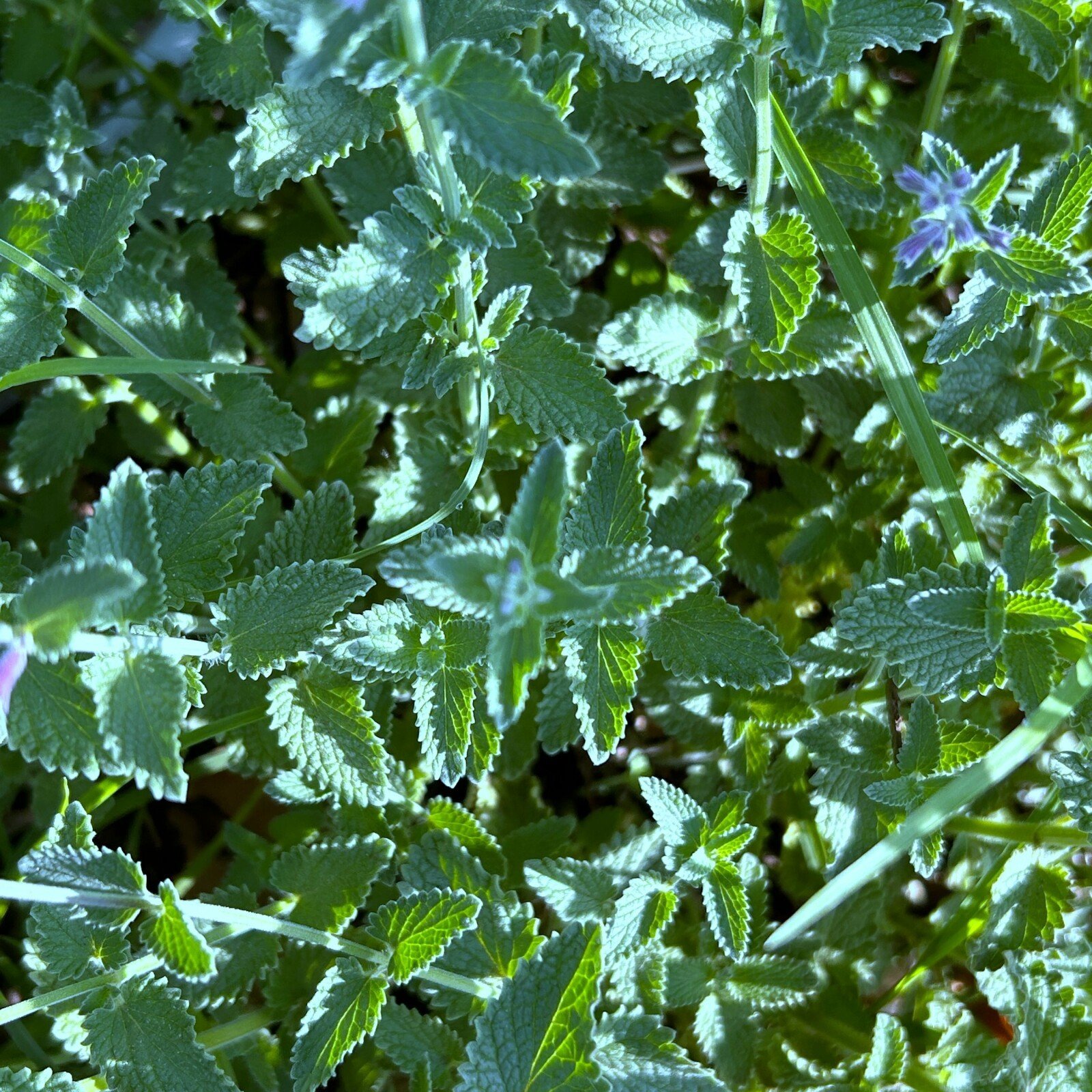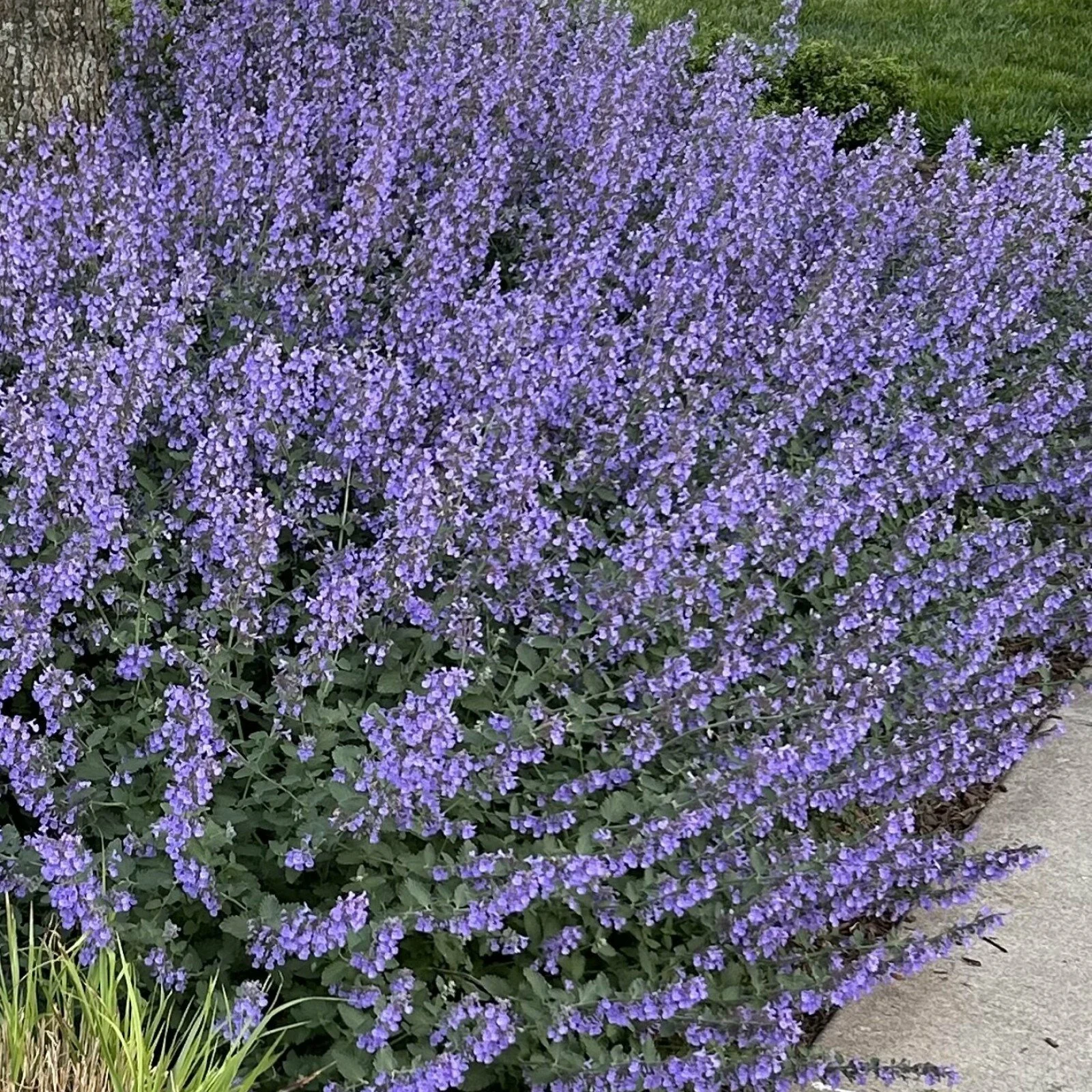Catmint
A Long-blooming Perennial with Pretty Purple Flowers
Catmint (Nepeta x faassenii) is an herbaceous perennial belonging to the mint family that shines as a fuss-free garden gem, gracing gardens in zones 4-7 with its vibrant, long season of bloom. There are a number of species in the Nepeta genus, including catnip, but the Nepeta x faassenii hybrids are by far the most popular landscaping plants. Butterflies and pollinators flock to the pretty flowers covering the plant from spring until late summer, and it has the added bonus of being rabbit and deer resistant, drought tolerant, and easy to grow in a wide range of soils.
Catmint plants typically have gray-green to silvery-green leaves that are aromatic when crushed. The leaves are opposite and toothed, and the plant produces spikes of small, tubular flowers. Catmint flowers come in shades of blue, purple, lavender, pink, or white, depending on the species or cultivar.
The fragrant foliage of catmint can attract cats, but they prefer catnip (Nepeta cataria), the weedy, self-seeding member of the Nepeta genus. If you are worried about attracting cats to your yard, steer clear of catnip and stick with catmint, such as the popular Nepeta x faassenii ‘Walker’s Low’, which cats generally leave alone (keep reading for more on catmint vs. catnip).
Catmint is known for its adaptability and tolerance of different soil types, including clay. It must have well-draining soil and is relatively drought-tolerant once established. This plant does best in full sun, and can still thrive and flower heavily with some afternoon shade. Catmint is a popular choice with gardeners and landscapers, preferred for its appealing foliage, long blooming period, and its ability to attract pollinators such as bees and butterflies. Read on to discover how to grow and care for this versatile flowering perennial, and get landscaping and companion planting ideas.
How to Plant and Grow Catmint
Location: Catmint prefers full sun (some afternoon shade is okay) and sandy or loamy, well-draining soil. It will tolerate most soil types, including clay. Do not plant catmint in wet, soggy, poorly draining soil - this can lead to root rot. If you have a sunny location with wet soil and are looking for a flowering plant, try swamp milkweed (Asclepias incarnata) instead.
Cultivar: Choose the catmint variety that suits your gardening goals (read on for a list of popular cultivars).
Planting: Plant catmint in the spring or fall; space plants 18 to 24 inches apart to allow for proper air circulation.
Watering: Water newly planted catmint regularly to help establish the roots. Once established, catmint is drought-tolerant (for watering guidance, see “How to Water Your Plants”).
Mulch: Apply a layer of mulch around catmint to conserve moisture and suppress weeds.
Fertilizer: Catmint usually does not require supplemental fertilization. A thin layer of compost (either homemade or store-bought), applied in early spring, will enrich the soil structure and support plant health.
Pruning: After the first flush of spring flowers, use sharp pruning shears to cut back the entire plant by about one-third to promote reblooming and bushier growth. You can also selectively prune specific stems or branches to shape the plant, if needed.
Pests and Diseases: Catmint is relatively resistant to pests and diseases, and can occasionally be bothered by aphids or spider mites. Overwatering and wet soil are the most frequent causes of problems with catmint - leaves turn yellow, starting at the bottom of the plant, and the stems turn a brown-black color.
How Do You Keep Catmint Blooming? Does Catmint Need to be Cut Back?
Deadheading: Regularly remove spent flowers by deadheading. This process involves cutting or pinching off the faded blooms. Deadheading prevents the plant from setting seed, redirecting its energy toward producing new flowers.
Pruning: When the first flush of spring flowers begin to fade, give catmint a light shearing or pruning and cut back the entire plant by about one-third. This will stimulate new growth and encourage a second round of blooming.
Dividing: Every few years, consider dividing mature catmint plants. This helps to rejuvenate the plant and can also promote increased flowering. Divide the plant in early spring or fall.
The silvery-green, aromatic foliage of Catmint.
Landscape Design Ideas for Catmint
Use catmint in hot, dry garden beds alongside walkways, sidewalks, or driveways. Plant in mass in a rock garden, or along the front of the border where it can spill over and soften the edges of a bed. Catmint attracts bees, butterflies, moths and hummingbirds and makes a great addition to any butterfly or pollinator garden.
For a sophisticated perennial planting, combine catmint with ‘Midnight Masquerade’ Beardtongue (a Penstemon hybrid) and ‘Helen von Stein’ Lamb’s Ears (Stachys). The larger leaf and flower shapes will contrast nicely with the soft mounds of silvery green catmint foliage, and the colors of each plant play nicely together.
For a structured planting, combine Otto Luyken cherry laurels (Prunus laurocerasus ‘Otto Luyken’), Golden Dream boxwoods (Buxus microphylla ‘Golden Dream’) and Cat’s Meow catmint (Nepeta faassenii ‘Cat’s Meow’). The large, glossy green leaves of the laurels and the small lime-green leaves of the boxwoods create a backdrop for the soft, silver foliage and purple flowers of catmint, and provide year-round evergreen structure.
Planting Companions for Catmint
Catmint stands out when planted in front of evergreen boxwoods like Buxus ‘SB108’ Newgen Independence® or Buxus ‘Green Mountain’. The purple flowers and silvery-green foliage of catmint contrast nicely with the lime green colors of Oak Leaf™ holly (Ilex conaf), Lemony Lace® elderberry (Sambucus recemosa ‘SMNSRD4’ Lemony Lace®) variegated liriope (Liriope muscari ‘Variegata’), or Little Lime® hydrangea (Hydrangea paniculata ‘Jane’ Little Lime®). When combining catmint with other perennials, go for strong leaf and flower shapes. Good choices include betony (Stachys officianalis ‘Hummelo’), white coneflower (Echinacea), blue flag iris (Iris versicolor), false indigo (Baptisia), and beardtongue (Penstemon).
Popular Cultivars of Catmint
‘Cat’s Meow’ (Nepeta x faassenii ‘Cat’s Meow’). A tidy, dense, uniform plant with purple-blue flowers, growing 17-20 inches tall.
‘Cat’s Pajamas’ (Nepeta ‘Cat’s Pajamas’). A petite, early blooming cultivar with rosy purple blooms. Grows 12-14 inches high.
‘Chartreuse on the Loose’ (Nepeta ‘Chartreuse on the Loose). Lime green foliage with lavender-blue spikes of flowers. Grows 8-10 inches tall, ideal for edging and the front of the border.
‘Kitten Around’ (Nepeta x faassenii ‘Kitten Around’). Purple-blue flowers on a compact and low growing plant, 12-14 inches tall.
Litte Trudy® (Nepeta ‘Psfike’ Little Trudy®). Compact, 8-10 inch tall plant for the front of the border. Purple flowers.
‘Neptune’ (Nepeta kubanica ‘Bokratune’). Smaller stature, growing 8-12 inches high. Leaves are a larger size and have a fresh green color; flowers are violet-blue.
‘Purrsian Blue’ (Nepeta x faassenii ‘Purssian Blue’). Periwinkle blue flowers cover a small, compact, tidy plant. Grows 14-18 inches tall.
‘Six Hills Giant’ (Nepeta ‘Six Hills Giant’). Tall, profusely flowering plant that grows to 36 inches high.
‘Snowflake’ (Nepeta x faassenii ‘Snowflake’). A white-flowered cultivar growing up to 14 inches tall.
SylvesterBlue™ (Nepeta x faassenii SylvesterBlue™). Profuse violet-blue flowers on dense, mounded plant. Grows 12-15 inches high.
‘Walker’s Deep Blue’ (Nepeta x ‘Walker’s Deep Blue’). Deep blue flowers, grows 18-20 inches tall.
‘Walker’s Low’ (Nepeta x faassenii ‘Walker’s Low’). Very popular, easy to find cultivar with a long season of bloom. Despite the name, this is a taller cultivar, growing to 30 inches high.
Whispurr™ Pink (Nepeta x faassenii Whispurr™ Pink). Larger soft pink flowers, grows 2 feet tall and wide.
Is Catmint Invasive? Does Catmint Spread?
The hybrid catmint cultivars have been specifically bred to be sterile, unable to produce seeds, and will not self-seed or spread without deliberate division. This includes all of the Nepeta x faassenii cultivars, and the hybrids like ‘Cat’s Pajamas’, Little Trudy®, ‘Neptune’, and ‘Walker’s Deep Blue’. The USDA does not currently consider catmint to be an invasive species (visit the USDA’s Database of Invasive and Noxious Plants).
Catnip (Nepeta cataria), on the other hand, will self-seed and spread aggressively, and can take over an entire garden when left unchecked.
Catmint vs. Catnip
Catmint and catnip are related plants, both belonging to the Nepeta genus, and they share similar characteristics like flower size, flower shape, and aromatic foliage. However, they are not exactly the same:
Catmint refers to various species and cultivars within the Nepeta genus (including Nepeta x faassenii ) grown for their ornamental value. They have a mounded, clump-forming shape, attractive foliage, and profuse flowers in spring and summer. Some cats may be attracted to catmint, but it does not have a strong effect on most cats and is usually ignored. Catmint is well-behaved in the garden, and does not aggressively seed and spread. It is a very popular, easy to grow ornamental plant, frequently planted by gardeners and landscapers.
Catnip (Nepeta cataria) is a specific species within the Nepeta genus that is well-known for its effect on cats. The compound nepetalactone, found in catnip, can induce a temporary euphoric or "happy" state in many cats, causing them to roll, rub, and nibble on the plant. Catnip has a weedier appearance than catmint, and it flowers sparsely. It also has a tendency to self-seed and spread in the garden. Because of its weedy, aggressive nature, catnip is not as commonly planted - it’s more of a niche plant grown by cat owners and herb gardeners interested in using the leaves for creating teas and insect repellents.
Plant catmint for pretty flowers…plant catnip for a feline frenzy!
Is Catmint Safe for Cats?
Yes, catmint is safe for cats. Catmint may not have the same effect on cats as catnip does, and may not induce the same playful behaviors associated with catnip, but it’s not considered toxic to cats.
Looking for cat-safe indoor plants? Read “Does your cat eat your houseplants?”.




